Perfectly Tender & Juicy Sous Vide Pork Loin: A Foolproof Recipe for Culinary Excellence
Unlock the secret to incredibly flavorful, uniformly tender, and irresistibly juicy pork loin roast every single time with the magic of sous vide cooking! This method guarantees a perfect result, making it an instant family favorite.
Pork is a beloved protein in our household, and for good reason! Its versatility is unmatched, offering a canvas for countless delicious meals. From quick weeknight dinners to impressive holiday roasts, there are literally a million different ways to prepare it. On our blog, you’ll find an abundance of pork recipes, but this Sous Vide Pork Loin Roast stands out as a consistently exceptional dish we’ve perfected over the years.
Forget everything you thought you knew about cooking pork loin. This recipe, seasoned simply with aromatic rosemary and fresh garlic, transforms an ordinary cut into something extraordinary. While we love this classic flavor combination, the beauty of sous vide allows for endless customization with your favorite spices and herbs. Once you experience the unparalleled tenderness and juiciness achieved with this cooking method, you’ll never go back to traditional roasting.
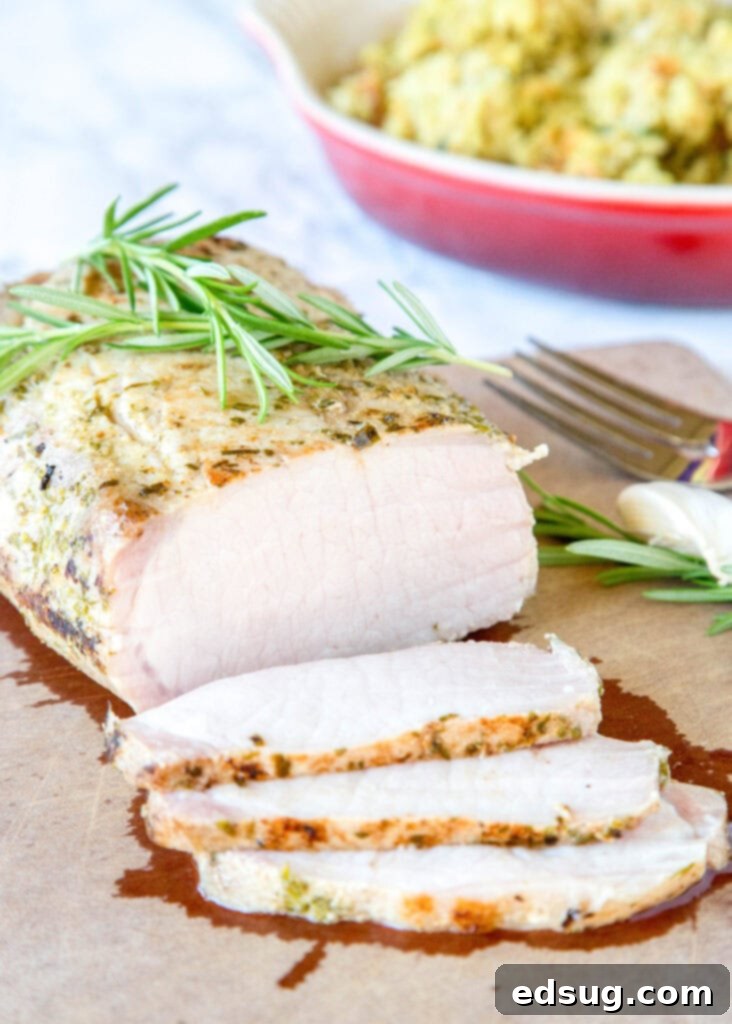
Why Sous Vide Your Pork Loin? The Secret to Unmatched Tenderness and Flavor
My culinary journey took an exciting turn a few years ago when I discovered sous vide cooking. This precision cooking technique has revolutionized how we prepare almost any protein we used to bake or stovetop cook. Even something as simple as Sous Vide Mashed Potatoes has ascended to a new level of creamy perfection in our kitchen.
The core principle of sous vide is its ability to maintain a precise water temperature, ensuring your food cooks evenly from edge to edge without ever overcooking. This means you can achieve an absolute perfect medium-rare steak, perfectly cooked Lamb Chop, or, in this case, an incredibly moist and tender pork loin, exactly to your preferred doneness. The result is a uniformly cooked interior that retains maximum moisture and flavor, far surpassing what’s possible with conventional methods. Trust me, once you experience the consistent excellence of sous vide, you’ll understand why it’s become a staple in our cooking repertoire.

How To Make Perfectly Sous Vide Pork Loin: Step-by-Step Guide
Creating this magnificent Sous Vide Pork Loin is surprisingly straightforward, especially considering the gourmet results you’ll achieve. Here’s a detailed breakdown of the process to ensure your pork loin comes out flawlessly tender and juicy:
- **Set Up Your Sous Vide Water Bath:** Begin by preheating your sous vide immersion circulator to a precise 140ºF (60ºC). Ensuring the water reaches the correct temperature before adding the pork is crucial for consistent cooking.
- **Prepare the Pork Loin:** In a small bowl, thoroughly mix together dried rosemary, minced garlic, salt, pepper, and a generous amount of olive oil. This aromatic rub will infuse deep flavor into the pork.
- **Generously Season the Pork:** Rub the prepared herb and garlic mixture liberally all over the pork loin roast, ensuring every surface is covered. Don’t be shy with the seasoning; it’s key to a flavorful final product.
- **Seal the Pork:** Carefully place the seasoned pork loin inside a vacuum-sealable plastic bag. If you have a vacuum sealer, use it to remove as much air as possible and seal the bag tightly. If you don’t have a vacuum sealer, a high-quality zip-top bag works perfectly. Seal the zip-top bag almost completely, then slowly lower the bag into the preheated water bath. The water pressure will help push out the remaining air. Once the pork is submerged and most of the air is expelled, seal the bag completely. This ensures direct contact between the water and the pork, facilitating even cooking.
- **Sous Vide Cook:** Once the water bath reaches the target temperature of 140ºF, carefully place the sealed bag of pork into the water, making sure it is fully submerged. Use a heavy object or a clip to keep it from floating if necessary.
- **Cook to Perfection:** Allow the pork loin to cook for 2 hours and 30 minutes. This duration ensures it reaches the ideal internal temperature and achieves maximum tenderness. You have a generous window with sous vide; the pork can safely remain in the water bath for up to 5 hours without overcooking or compromising texture, offering great flexibility for meal timing.
- **Pat Dry for Searing:** Once cooked, remove the pork from the bag and gently pat it completely dry with paper towels. Removing excess moisture is vital for achieving a beautiful, crispy sear.
- **Prepare for Searing:** Heat 1 tablespoon of vegetable or avocado oil in a large skillet over high heat. The oil should be shimmering, indicating it’s hot enough to create a quick, effective sear.
- **Sear for Golden Crust:** Carefully place the pork loin roast in the scorching hot pan. Cook for approximately 30-45 seconds per side, rotating until all surfaces are beautifully browned and form a delicious crust. This step adds incredible texture and depth of flavor.
- **Slice and Serve:** Immediately remove the pork from the pan, slice it into desired portions, and serve hot. Enjoy the incredibly tender and juicy results of your sous vide masterpiece!
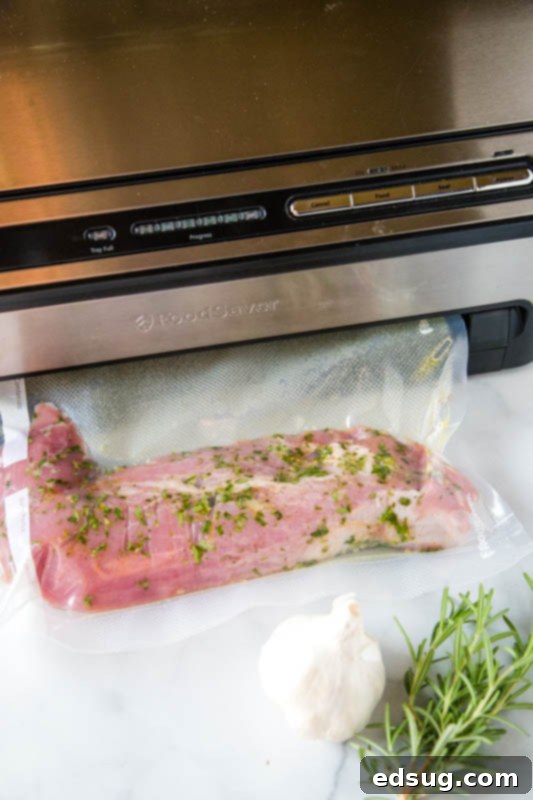
Understanding Sous Vide Pork Temperatures: Safety and Sensation
When cooking pork with traditional methods like baking or pan-frying, the general recommendation for food safety is to reach an internal temperature of 145ºF (63ºC) and hold it for at least 1 second to eliminate harmful bacteria. However, sous vide cooking operates on a different principle, offering a significant advantage in terms of both safety and desired doneness.
With sous vide, you hold the meat at a consistent, lower temperature for an extended period. This prolonged exposure at a stable temperature effectively pasteurizes the meat, killing bacteria and making it perfectly safe to eat, even at temperatures below the traditional 145ºF guideline. This scientific approach allows for a much more controlled and tender outcome, as the meat is never subjected to extreme heat that can dry it out.
For this Sous Vide Pork Loin recipe, we recommend setting your sous vide to 140ºF (60ºC). This temperature yields an exceptionally juicy, tender, and slightly pink (medium) pork loin that is bursting with flavor. If you research other sous vide pork recipes, you might find some suggesting 137ºF (58.3ºC). While 137ºF will result in a slightly pinker interior, it is still entirely safe to consume due to the extended cooking time at that stable temperature. The choice between 137ºF and 140ºF often comes down to personal preference for doneness and texture, with 140ºF offering a slightly firmer yet still incredibly moist texture.
Remember, the beauty of sous vide is precision. Once you find your preferred temperature, you can consistently achieve it every time, eliminating guesswork and delivering restaurant-quality results in your home kitchen.
Sous Vide Pork Loin Cooking Times: Flexibility and Flavor
One of the most appealing aspects of sous vide cooking is its inherent flexibility, and this holds true for pork loin. Unlike conventional cooking methods where timing is critical to prevent overcooking, sous vide allows for a generous window. For a typical pork loin, you can expect optimal results when cooking anywhere from 2 1/2 hours to 5 hours in the water bath.
This means your pork loin will be perfectly safe to eat and reach its ideal tenderness and juiciness at the 2 1/2-hour mark. However, if your schedule demands it, you can leave it in the water bath for up to 5 hours. During this extended period, the meat will continue to tenderize without becoming dry or overcooked, thanks to the precise temperature control of the sous vide. This “set it and forget it” flexibility is a huge advantage for busy cooks or when entertaining guests.
It’s important to note that while the window is flexible, exceeding 5 hours can start to affect the meat’s texture. Beyond this point, the muscle fibers may begin to break down excessively, potentially leading to a softer, somewhat mushy texture that diminishes the desired mouthfeel. Sticking within the 2.5 to 5-hour range will ensure your pork loin remains wonderfully tender and firm.
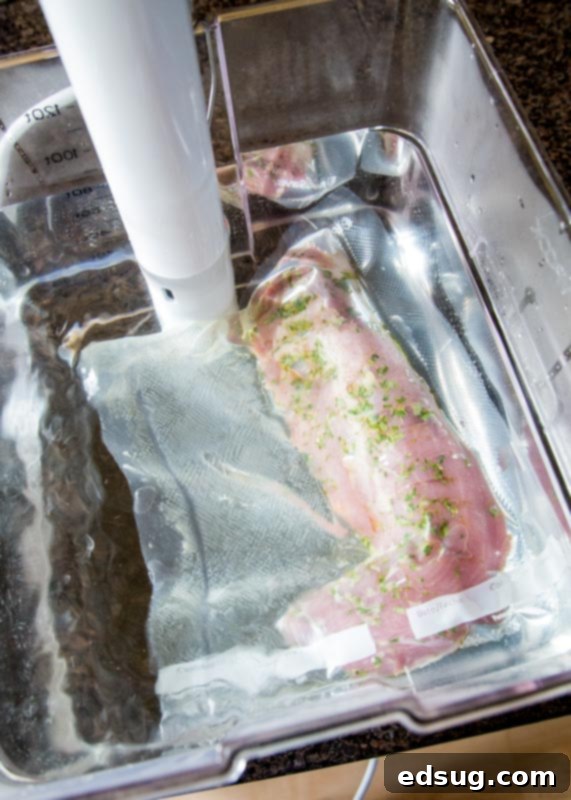
Pork Loin vs. Pork Tenderloin: Understanding the Cuts
A common point of confusion for many home cooks is the difference between pork loin and pork tenderloin. While both are delicious cuts from the pig, they are distinct and require slightly different approaches to cooking. The short answer is no, they are not the same cut of meat.
If you happen to have a pork tenderloin, you’ll want to refer to specific recipes designed for it, such as our Sous Vide Pork Tenderloin recipe. While the sous vide method remains similar, the cooking times for tenderloin are typically shorter due to its smaller size and thinner profile.
Let’s delve into the longer explanation:
- Pork Tenderloin: This cut is a long, narrow, and lean muscle that runs along the backbone of the pig. It’s renowned for its exceptional tenderness and has a more pronounced, rich pork flavor. Due to its delicate nature, it cooks relatively quickly and can dry out easily with conventional methods, making sous vide an ideal technique to preserve its moisture.
- Pork Loin: In contrast, a pork loin is a wider, flatter, and significantly larger cut of meat, often sold as a roast. It can sometimes be found with the bone in, though boneless varieties are very common. Pork loin is also a tender cut, but it tends to be milder in flavor compared to the tenderloin. Its larger size means it benefits immensely from the even cooking of sous vide, which prevents the outer parts from drying out while the center cooks. This recipe specifically focuses on achieving perfection with a pork loin roast.
Understanding these differences ensures you select the right recipe and cooking method for the specific cut of pork you’re preparing, guaranteeing the best possible results.
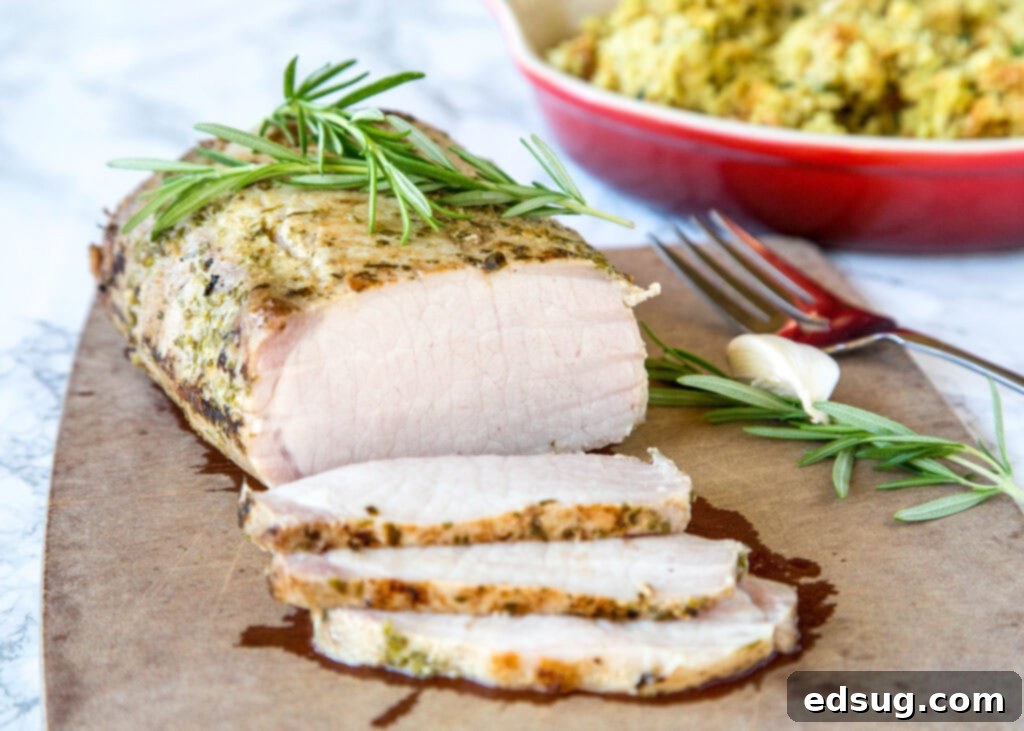
Can You Sous Vide Frozen Pork Loin? Absolutely!
One of the many conveniences of sous vide cooking is its incredible flexibility with frozen ingredients. Yes, you can absolutely sous vide a frozen pork loin! This makes meal planning and impromptu dinners a breeze, as there’s no need to thaw your pork beforehand.
The process remains largely the same: season your frozen pork loin as usual, seal it in a vacuum bag, and place it directly into your preheated sous vide water bath. The only adjustment required is an extended cooking time. For a frozen pork loin, simply add an extra 60 minutes (1 hour) to your total cook time. This additional hour allows the meat to thaw and come up to temperature in the precise water bath before it begins its tenderizing cook. Follow all other steps, including the crucial post-sous vide searing, for a perfectly cooked result.
Essential Sous Vide Tips for Pork Loin Perfection
To ensure your sous vide pork loin is nothing short of spectacular, keep these expert tips in mind:
- The Importance of Searing: While sous vide cooks the pork to perfection internally, a final sear is non-negotiable. Searing creates a beautiful, caramelized crust (the Maillard reaction) that adds an incredible depth of flavor and texture, elevating the entire dish. Don’t skip this step!
- Achieve a Perfect Crust by Drying Thoroughly: For the best sear, it’s absolutely crucial to pat the pork loin very, very dry with paper towels after removing it from the sous vide bag. Any moisture on the surface will steam the meat instead of searing it, preventing that desired crispy crust.
- Sizzle with High Heat: When it’s time to sear, ensure your pan is piping hot and the oil is shimmering. Your pork is already cooked to its ideal internal temperature, so the goal of searing is to create a crust as quickly as possible without further cooking the interior. A hot pan ensures a rapid, effective sear in just 30-45 seconds per side, minimizing additional cooking.
- Season Generously and Creatively: Sous vide allows seasonings to deeply penetrate the meat. Don’t be shy with your rub! While rosemary and garlic are a fantastic classic, feel free to experiment with different herb blends, spices, or even a dry brine. Ensure every surface of the pork is well-coated for maximum flavor.
- Cover Your Water Bath: If your sous vide setup doesn’t include a lid, or even if it does, covering the water bath with plastic wrap, aluminum foil, a cookie sheet, or a pot lid is a smart move. This simple trick significantly reduces water evaporation, preventing the need to refill the bath during longer cooking times. It also helps to maintain a more stable water temperature, contributing to more consistent results.
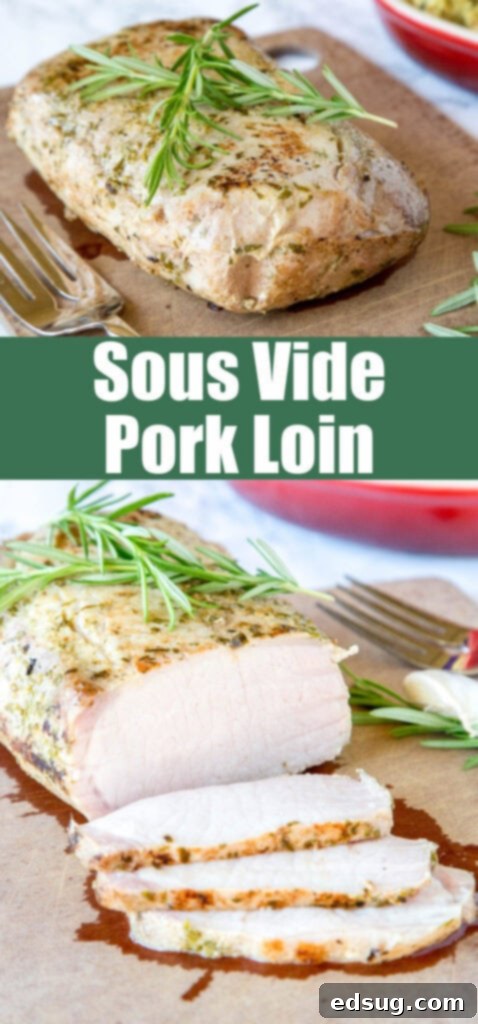
What to Serve with Your Sous Vide Pork Loin
A perfectly cooked pork loin deserves equally delicious accompaniments. Here are some ideas to round out your meal:
- **Creamy Mashed Potatoes:** As mentioned, Sous Vide Mashed Potatoes are incredible, but any classic mashed potato recipe works beautifully.
- **Roasted Vegetables:** Asparagus, Brussels sprouts, or root vegetables like carrots and parsnips roasted with herbs complement pork wonderfully.
- **Fresh Green Salad:** A light, crisp salad with a vinaigrette dressing can cut through the richness of the pork.
- **Apple Sauce or Chutney:** The sweetness and tartness of apple sauce or a homemade fruit chutney are classic pairings for pork.
- **Grain Pilaf:** A wild rice pilaf or quinoa salad can add a healthy and textural contrast.
Explore More Delicious Pork Dinner Recipes
If you’re as big a fan of pork as we are, you’ll want to check out these other fantastic recipes:
- Slow Cooker Pork Roast
- Smothered Pork Chops
- Baked Pork Chops
- Gyoza (Japanese Style Pork Dumplings)
- Pork Lo Mein
- Pork Adobo

Sous Vide Pork Loin
Pin Recipe
Rate Recipe
Print Recipe
Ingredients
- 1 pork loin roast, 3-4 pounds
- 6 cloves garlic, minced
- 1 Tablespoon dried rosemary
- 2 teaspoons salt
- 1 teaspoon black pepper
- 3 Tablespoons olive oil
- 1 Tablespoon vegetable or avocado oil
Instructions
-
Preheat the water bath using your sous vide to 140ºF (60ºC).
-
Season pork with salt and pepper on all sides.
-
Mix together the rosemary, garlic, and 3 Tablespoons olive oil and generously rub all over the pork.
-
Place the pork inside your plastic bag. If using a vacuum sealer, seal the bag. If you do not have a vacuum sealer, use a zip-top bag and seal it almost all the way. Slowly add the bag to the water bath until just below the top is submerged (this uses water displacement to remove air). Then seal the rest of the bag to ensure most of the air is out.
-
Once the water is up to temperature, place the sealed bag of pork in the water, making sure it is fully submerged.
-
Cook for 2 hours and 30 minutes (you can leave it cooking for up to 5 hours and still have it be perfectly tender).
-
Remove pork from the bag and use a paper towel to pat it completely dry.
-
Heat 1 Tablespoon of vegetable or avocado oil in a large skillet over high heat. Once the oil is shimmering, you know it is hot enough.
-
Carefully place the pork loin in the pan and cook for about 30-45 seconds a side, until it is nicely browned and a beautiful crust has formed.
-
Remove from the pan, slice against the grain, and serve immediately. Enjoy!
Nutrition
Nutrition information is automatically calculated, so should only be used as an approximation.
Additional Info
Like this recipe? Leave a comment below!
I’d love for you to join our fun community on Facebook! It’s a fantastic space where you can share your favorite recipes, ask questions, and stay updated with all the latest delicious creations from Dinners, Dishes, and Desserts. Never miss a new recipe!
Be sure to follow me on Instagram and tag #dinnersdishes so I can see all the wonderful DINNERS, DISHES, AND DESSERTS recipes YOU make!
Stay connected and never miss a post!
Facebook | Twitter | Pinterest | Instagram
